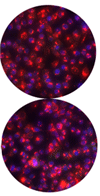What can the service do?
Collaborative assay development
Assay development in collaboration with individual laboratories is a fundamental aspect of the work of the facility as the assay dictates the informational content, efficiency of time and resource consumption, and cost of each screen. Therefore, special attention is paid to the possibility of creating multiplex homogenous assays and high content, image-based assays. Assay development can apply equally to existing assays, as well as those in development or still theoretical. In addition, the facility is also actively engaged in the development of secondary screens which can form an important part of the validation process.
Types of assays
Various different assay formats figure in the work of the facility covering a range of biological questions and systems such as cell-based loss-of-function, modifier and synthetic lethal screens, as well as cell-free screens for small molecule inhibitors.
- siRNA screens
Currently, the work of the facility is dominated by siRNA screens. The types of assay readout can include high-content microscopy, homogenous enzymatic assays and cell viability assays. We can perform screens using well-established, cell lines or user generated, stably transfected cell lines. We have several small functionally defined siRNA libraries as well as the full genome library supplied by Dharmacon. In addition we manage the full genome deconvoluted library, which we can cherry pick for secondary screens.
- Small molecule inhibitor screens
Basic research has a great need for cell-soluble, small molecule inhibitors of cellular processes or individual activities within signalling pathways. We currently hold a large collection of small molecules from ChemBridge, as well as smaller, focused small molecule libraries.
Types of project can include inhibitors of protein-protein or protein-peptide interactions, inhibitors of specific enzymatic activities or concerted biological process using either purified proteins, crude in vitro extracts, cell-based assays or organism-based assays. Traditional enzymatic and fluorescence-based assay readouts, ranging from simple 'yes/no' assays to fluorescence polarisation can also be developed.
The vision of the facility is:
- To provide a high quality service capable of performing large- and small-scale screening projects involving a wide range of assay techniques and addressing a diversity of biological questions reflecting the range of activities of laboratories within the Crick
- To become a centre of excellence in screening matters both within the Crick and the wider scientific community, providing a centralised distribution centre for materials and advice within the Crick and creating a large biologically relevant dataset for analysis by Crick laboratories
Members of the HTS Lab
- Michael Howell (Lab Head)
Email: michael.howell@crick.ac.uk
Tel: 0207 269 3170 - Ming Jiang (Deputy)
Email: ming.jiang@crick.ac.uk
- Rachael Instrell (Principal Scientific Officer)
Email: rachael.instrell@crick.ac.uk
- Becky Saunders (Principal Bioinformatian)
Email: becky.saunders@crick.ac.uk
- Mary Wu (Senior Laboratory Research Scientist)
Email: mary.wu@crick.ac.uk
- Rodrigo Fernandes Redondo (Senior Laboratory Research Scientist)
Email: rodrigo.redondo@crick.ac.uk
Screening Reviews
The following publications provide useful reviews of RNAi screening and analysis.
- Vigilance and validation: Keys to success in RNAi screening.
Sigoillot et al., 2011. ACS Chem Biol. 2011 6:47-60. - Genomic screening with RNAi: results and challenges.
Mohr et al., 2010. Annu Rev Biochem. 2010 79:37-64. - High-throughput RNAi screening to dissect cellular pathways: a how-to guide.
Falschlehner et al., 2010. Biotechnol J. 2010 5:368-76. - Tales from an academic RNAi screening facility; FAQs.
Brief Funct Genomics. 2011 10:227-37.